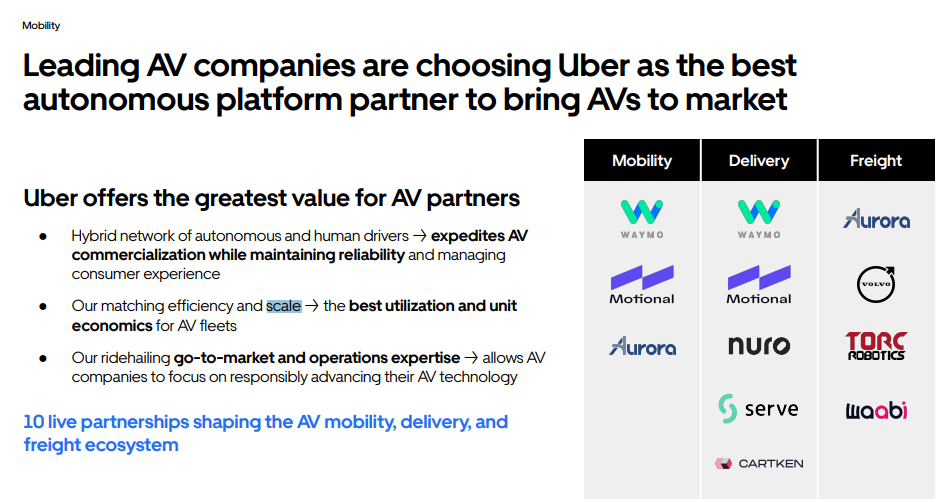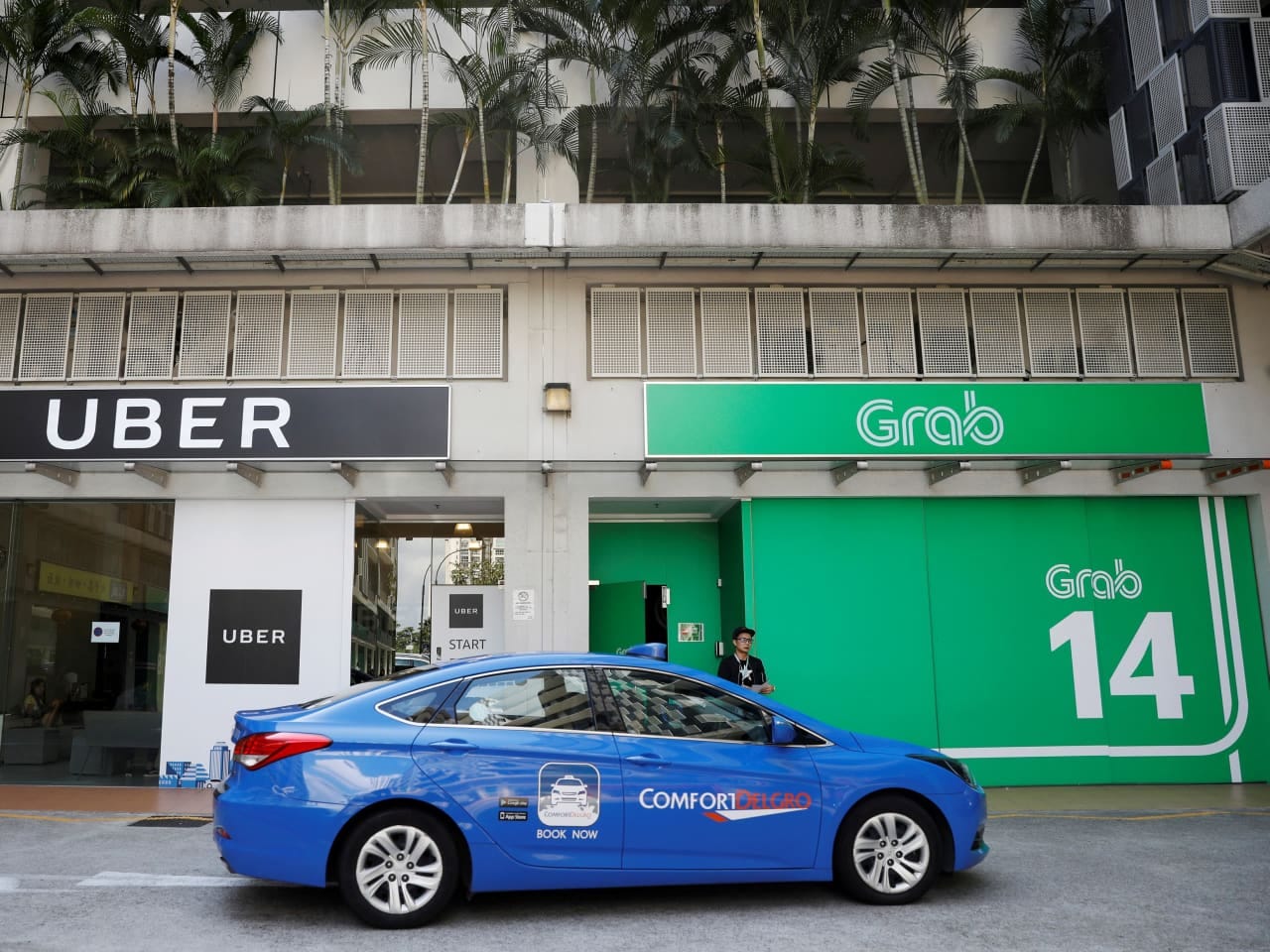Are You Ready to Understand Uber's Competitive Advantage?
Uber Technologies Inc. has evolved far beyond a simple ride-hailing service since its founding in 2009. Today, Uber is a global leader in the transportation and technology sectors, offering a variety of services including Uber Eats, Uber Freight, and investments in autonomous vehicle technology. But what makes Uber so hard to beat? The answer lies in its competitive moat—those crucial advantages that give Uber an edge over competitors and position it for long-term dominance.
In this analysis, I’m diving into the key aspects of Uber's moat, from network effects to technological innovations, to show you why Uber is built to last. If you want to learn more about Uber or other promising stocks, like Synopsys, head over to my Substack for more in-depth stock analysis.
Uber's Business Model: More Than Just a Ride-Hailing Service
Uber operates with a model that’s far more than just a ride-hailing app. It has created an ecosystem that blends people, technology, and innovation. One of the most significant advantages Uber has is its asset-light strategy—it doesn’t own the cars but instead connects independent drivers with riders, allowing Uber to scale quickly with minimal upfront costs. This business model also enables Uber to expand rapidly into new markets without the burden of vehicle ownership.
Another powerful aspect of Uber's moat is its diverse service offerings. In 2024, Uber Eats generated $14.6 billion in revenue alone. Its freight business and ongoing development in autonomous vehicles further solidify Uber's competitive edge, attracting new users and creating additional revenue streams that competitors simply can’t replicate. This strategy also enables Uber to capture a wide range of customers and keep them engaged across multiple services.
Uber’s vertical integration strategy, investing in autonomous vehicles and drone delivery systems, is positioning the company to control more of the supply chain. This gives Uber a long-term advantage, as it continues to expand its influence across multiple industries.
Now, let’s dive into each aspect of the moat:
Network Effects
Technological Innovation
Economies of Scale
Brand Recognition
Network Effects: Uber's Key to Maintaining Its Lead
Uber’s competitive advantage is largely driven by its powerful network effects, and this is something we can relate to from our daily lives. Think about how much easier it is to make a dinner reservation at a popular restaurant. The more people dine there, the better the experience for everyone. Why? Because the restaurant gets better at managing crowds, the service improves, and the food becomes more consistently high-quality. The same goes for Uber. The more people that use Uber’s platform, the more valuable it becomes for both riders and drivers. For riders, a larger driver base leads to shorter wait times and better geographic coverage, which significantly improves their overall experience. It’s like when you go to your favorite coffee shop, and they’ve perfected the process so you get your coffee just how you like it—quickly. Uber’s ability to match riders with nearby drivers efficiently mirrors this process, ensuring a smoother, more predictable ride every time.
For drivers, the platform’s attractiveness grows as more riders join the service. The larger the rider base, the more opportunities drivers have to earn. Think about how a neighborhood restaurant becomes more profitable as more locals and tourists discover it. It’s the same with Uber. As Uber’s 161 million monthly active users in 2024 continue to use the platform, more drivers are drawn in because they see a better potential for higher earnings and less idle time. This growing demand creates a self-reinforcing cycle. Just like how a busy gym attracts more fitness enthusiasts because they know the equipment is always available and in demand, Uber’s increasing customer base means drivers have more work, and riders see shorter wait times.
Now, consider Uber’s international reach—it’s a bit like having access to your favorite streaming service no matter where you go in the world. If you’re traveling to another country, you can count on being able to get an Uber just like you would back home, which makes your trip so much easier. Uber operates in over 10,500 cities across 70 countries, making it a familiar and reliable option wherever you are. This scale enhances Uber’s network effects, ensuring that no matter where you are, you’ll find a ride available, and the driver will always be nearby. This global presence creates a barrier to entry for competitors who don’t have the same reach.
In everyday life, network effects are all around us—from the social media apps we use to the online marketplaces we shop on. With Uber, these effects have created a platform that continues to grow stronger with each new rider and driver. The more users Uber gains, the more valuable it becomes for everyone involved. With 161 million monthly active users globally in 2024, Uber’s network has become so established that it’s tough for competitors to offer the same experience. Just like how you can rely on your favorite restaurant or a well-known app, Uber has built a reliable system that’s hard to beat—making it a dominant force in the transportation industry.
Technological Innovation: Staying Ahead of the Competition
Technological innovation is at the heart of Uber’s ability to stay ahead of its competitors, and it’s a concept we can all relate to. Think about how much we rely on technology in our daily lives. Whether it’s using our phones to check the weather or checking our bank balance with a few taps, technology has made tasks more efficient and streamlined. Uber has embraced this very idea, pushing the boundaries with autonomous vehicle initiatives to reduce its dependence on human drivers and scale more effectively.
Uber has made significant investments in autonomous vehicle technology over the years. The company remains committed to developing self-driving technology, aiming for a future with driverless rides. Although Uber sold its self-driving division, Uber ATG, to Aurora Innovation in 2020, the company continues to partner with other companies, like Waymo (owned by Alphabet), to develop autonomous vehicles. As autonomous vehicles become more widespread, Uber is well-positioned to be a leader in the market.
Uber’s ability to continuously innovate extends beyond autonomous vehicles. Consider how your favorite app gets frequent updates—sometimes adding new features, improving design, or streamlining the user experience. Uber takes a similar approach with its platform, constantly refining its technology to improve ride matching and dynamic pricing. Uber’s algorithms, powered by vast amounts of data, use real-time information and predictive analytics to pair riders with drivers quickly, reducing wait times and optimizing the ride experience. This technology is particularly noticeable during peak hours. Surge pricing, which adjusts prices when demand exceeds supply, is one such feature that Uber has refined over time to ensure both drivers and riders are compensated fairly when demand is high.
The more Uber collects data, the more it can refine its services to meet user needs. Think about how online shopping platforms use your past purchases to recommend similar products you might like. Uber applies this idea to its platform, gathering data on ride patterns, user behavior, and even geographic demand. By continuously analyzing this data, Uber fine-tunes its algorithms, ensuring its platform runs smoothly and more efficiently. This data-driven decision-making has helped Uber stay ahead in an industry where competition is fierce.
Uber’s commitment to technological innovation has given it a powerful competitive edge. By investing in cutting-edge technologies like autonomous vehicles and refining its ride-matching algorithms, Uber continues to provide a seamless experience for both riders and drivers. It’s similar to how a trusted app on your phone evolves over time to make your life easier—Uber is constantly evolving to meet the changing needs of its users, keeping it ahead of the curve in a rapidly changing market.
Economies of Scale: How Uber Makes Expansion Look Easy
Uber’s economies of scale play a crucial role in its ability to operate efficiently and stay competitive. Think about how businesses we interact with daily can offer better deals the more they grow—like grocery stores that offer bulk discounts as they expand. Similarly, Uber’s massive scale allows it to negotiate better deals with suppliers and vendors, reducing costs and boosting profitability. Whether it's securing better pricing for car maintenance or negotiating software deals, Uber’s sheer size gives it a powerful advantage.
As Uber grows, its ability to keep costs low improves, especially as the company adds new services like Uber Freight and Uber Eats. Just like how a family may start buying groceries in bulk to save money over time, Uber reduces its per-unit costs with every new service added, enabling it to expand quickly without drastically increasing expenses. This ability to scale effectively is vital as Uber seeks to continue its growth across different markets.
Uber’s operational efficiency is also a key element of its success. Picture how a large company, like a tech giant, might create streamlined processes to ensure that all employees are on the same page across multiple offices worldwide. Uber does something similar by standardizing core business processes, such as pricing algorithms and customer service protocols. This allows Uber to maintain efficiency and consistency, even with its broad reach across multiple cities and countries.
As Uber continues expanding its network, the efficiencies increase. Its existing base of drivers and customers makes it easier to launch new offerings like Uber Freight (for transporting goods) or Uber Eats (for food delivery) without incurring significant additional costs. The more Uber scales, the more it benefits from this interconnected network, reinforcing its position as an industry leader.
Ultimately, Uber’s economies of scale give it the ability to lower costs, increase efficiency, and expand its reach globally. Whether through negotiating better deals or optimizing its operations, Uber’s massive scale continues to drive its success in the fast-paced and competitive market.
Brand Recognition: Building Trust and Customer Loyalty
Uber’s brand recognition plays a crucial role in its competitive edge. Think about how brands like Starbucks and Apple have become so ingrained in our daily routines that we automatically trust them. Uber has achieved this level of familiarity, with over 161 million monthly active users in 2024. It’s become a household name for many, known not just for reliable transportation, but also for a range of services that have seamlessly integrated into people’s lives.
One of the ways Uber builds and strengthens customer loyalty is through its Uber One membership program, which has gained impressive traction with 25 million members in 2024. Just like how a Starbucks Rewards program or an Apple loyalty program offers incentives for repeat business, Uber One provides users with benefits across Uber’s ecosystem—whether it’s discounts on rides, food delivery, or even other perks. This program keeps customers engaged and encourages them to stick with Uber for multiple services, which is key to building a long-term customer base.
What sets Uber apart from many competitors is its ability to offer a consistent and user-friendly experience across its various services. Consider how convenient it is to order food from Uber Eats, much like how you would easily order a coffee from Starbucks or purchase a new device from Apple’s streamlined website. Uber brings this same level of ease to all its offerings. Whether it's hailing a ride, ordering food, or managing freight logistics, Uber provides a seamless, consistent experience that keeps users coming back.
With operations in over 10,500 cities worldwide, Uber’s global brand recognition is another major strength. When people think of getting a ride, Uber is often the first name that comes to mind, making it a powerful player in the global transportation market. This recognition gives Uber a significant advantage, helping it not only with customer acquisition but also with its ability to penetrate markets more effectively than competitors.
In addition to its core services, Uber benefits from its acquisition of Grab, which operates across Southeast Asia. Grab has become a trusted name in its own right, expanding beyond ride-hailing to offer food delivery and digital payment services. The integration of Grab into Uber’s ecosystem further strengthens Uber’s global presence, allowing it to tap into the rapidly growing Southeast Asian market while providing a consistent user experience across regions.
In essence, Uber’s brand recognition, bolstered by customer loyalty programs like Uber One, and a user-friendly, consistent experience across services, positions the company as a dominant force in the mobility industry. Its vast reach and ability to stay top-of-mind for millions of users make it a go-to choice for transportation, food delivery, and more.
Uber’s Moat: Built to Last
Uber’s moat is WIDE, deep, and incredibly difficult to replicate. With strong network effects, ongoing technological advancements, economies of scale, and powerful brand recognition, Uber is poised for long-term success. As the company continues to innovate—especially in areas like autonomous vehicles and AI-driven logistics—it’s clear that Uber is not just a leader in the transportation industry but a company with an enduring competitive advantage.
Want to Stay Ahead of the Curve?
If you’re serious about uncovering stocks with strong competitive advantages, subscribe to my Substack for quick, insightful stock analyses that are easy to digest in just 5-10 minutes. Plus, I’ve already analyzed Synopsys—check it out now and make more informed investing decisions.
















